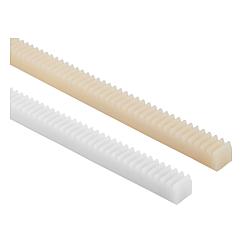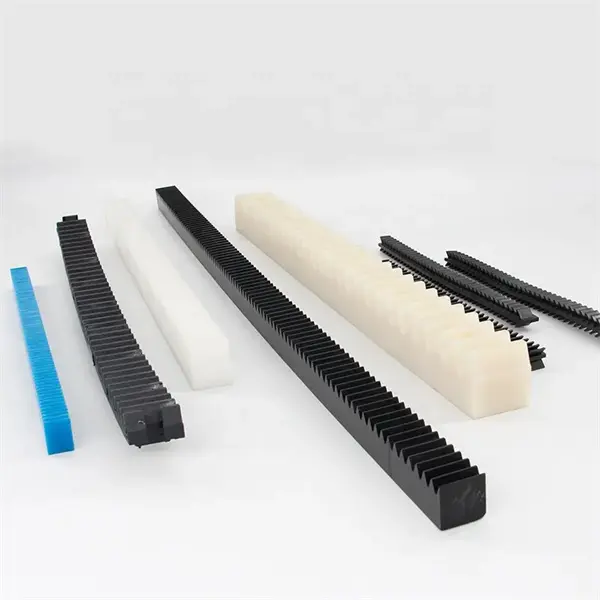Product Description
Product Description
The working principle of pinion and rack is to convert the rotary motion of the gear into the reciprocating linear motion of the rack, or the reciprocating linear motion of the rack into the rotary motion of the gear. Suitable for fast and accurate
positioning mechanism, suitable for heavy load, high precision, high rigidity, high speed and long stroke CNC machine tools,machining centers, cutting machinery, welding machinery, etc., suitable for factory automation fast transplanting machinery,industrial robot arm grasp mechanism, etc.
|
Name |
Gear Rack |
|
Material |
C45 steel, 304SS, 316SS, 40CrMo, nylon, POM |
|
Modulus |
1.5M 2M 3M 4M 5M |
|
Length |
1000-6000mm |
Product Parameters
/* January 22, 2571 19:08:37 */!function(){function s(e,r){var a,o={};try{e&&e.split(“,”).forEach(function(e,t){e&&(a=e.match(/(.*?):(.*)$/))&&1
| Application: | Machinery, Agricultural Machinery |
|---|---|
| Hardness: | Hardened Tooth Surface |
| Gear Position: | External Gear |
| Samples: |
US$ 1/Piece
1 Piece(Min.Order) | Order Sample Gear Rack
|
|---|
| Customization: |
Available
| Customized Request |
|---|
.shipping-cost-tm .tm-status-off{background: none;padding:0;color: #1470cc}
|
Shipping Cost:
Estimated freight per unit. |
about shipping cost and estimated delivery time. |
|---|
| Payment Method: |
|
|---|---|
|
Initial Payment Full Payment |
| Currency: | US$ |
|---|
| Return&refunds: | You can apply for a refund up to 30 days after receipt of the products. |
|---|

How do rack and pinion systems handle variations in load capacity and speed?
Rack and pinion systems are designed to handle variations in load capacity and speed effectively. Here’s a detailed explanation of how they handle these variations:
- Load Capacity: Rack and pinion systems can be designed to accommodate a wide range of load capacities. The load capacity primarily depends on the strength and size of the rack and pinion components, such as the rack material, tooth size, and pinion gear dimensions. By selecting appropriate materials and dimensions, rack and pinion systems can be optimized to handle varying load capacities. For higher load requirements, heavier-duty materials and larger gear sizes can be used to ensure sufficient strength and durability.
- Speed: Rack and pinion systems can also handle variations in speed. The speed of the system is influenced by factors such as the rotational speed of the pinion gear and the pitch of the rack. By adjusting these parameters, the speed of the system can be optimized to suit specific application requirements. For high-speed applications, rack and pinion systems can be designed with smaller pitch and lighter components to minimize inertia and allow for rapid acceleration and deceleration. On the other hand, for slower-speed applications, larger pitch and heavier components can be used to enhance stability and load-carrying capacity.
- Lubrication and Maintenance: Proper lubrication is crucial for the smooth operation and longevity of rack and pinion systems. Lubricants help reduce friction and wear between the rack and pinion gears, ensuring efficient power transmission and minimizing the risk of damage. The type and frequency of lubrication required may vary depending on the load capacity and speed of the system. Regular maintenance, including inspection and lubrication, is important to ensure optimal performance and longevity of the rack and pinion system under varying load and speed conditions.
- Design Considerations: When designing rack and pinion systems, it is essential to consider the anticipated load capacity and speed requirements. Factors such as gear material selection, tooth profile, gear module, and tooth width play a significant role in determining the system’s ability to handle variations in load and speed. The design should take into account the maximum expected load and speed to ensure that the rack and pinion components are appropriately sized and capable of withstanding the anticipated conditions.
- System Feedback and Control: In applications where load and speed variations are significant, incorporating system feedback and control mechanisms can enhance the performance of rack and pinion systems. Sensors and feedback devices can be used to monitor the load and speed, allowing for real-time adjustments and control. This feedback information can be utilized to implement closed-loop control systems that adjust the motor torque or speed to maintain precise motion control under varying load conditions.
By considering factors such as load capacity, speed, lubrication, maintenance, and design considerations, rack and pinion systems can effectively handle variations in load and speed, ensuring reliable and precise motion control in a wide range of applications.

Can rack and pinion mechanisms be applied in CNC machining for positioning?
Yes, rack and pinion mechanisms can be successfully applied in CNC machining for precise positioning of machine tools and workpieces. Here’s a detailed explanation of how rack and pinion mechanisms can be utilized in CNC machining:
Rack and pinion mechanisms offer several advantages that make them suitable for positioning in CNC machining:
- Precision and Accuracy: Rack and pinion systems provide high precision and accuracy in positioning. The direct engagement between the pinion and the rack ensures a positive and backlash-free transfer of motion, allowing for precise movement and positioning of machine tools and workpieces. This characteristic is essential in CNC machining, where tight tolerances and accurate positioning are required.
- High Speed and Acceleration: Rack and pinion systems are capable of accommodating high-speed movements and rapid accelerations. The direct power transmission and efficient torque transfer of rack and pinion mechanisms enable quick and dynamic positioning, reducing idle times and improving overall machining efficiency. This characteristic is advantageous in CNC machining, where fast tool changes and rapid workpiece positioning are crucial for productivity.
- Load Handling Capability: Rack and pinion systems can handle significant loads while maintaining precise positioning. The engagement of the teeth provides a large contact area, allowing for the effective distribution of forces and torque. This capability is important in CNC machining, where heavy-duty cutting operations and the manipulation of large workpieces may be required.
- Compact Design: Rack and pinion systems offer a compact design, which is advantageous in CNC machining setups with limited space. The linear nature of the rack allows for efficient integration into the machine’s structure, minimizing the overall footprint. This compact design maximizes the workspace utilization and allows for flexible placement of the rack and pinion mechanism.
- Compatibility with CNC Control Systems: Rack and pinion systems can be easily integrated with CNC control systems. The position and motion of the rack and pinion mechanism can be precisely controlled and programmed using CNC software. This compatibility allows for seamless coordination between the rack and pinion system, servo motors, and other machine axes, enabling synchronized and coordinated movements for complex machining operations.
- Reliability and Durability: Rack and pinion systems are known for their durability and long service life. When properly designed and maintained, they can withstand the demands of CNC machining, including continuous operation, high speeds, and repetitive movements. This reliability is vital in CNC machining, where machine uptime and consistent performance are critical.
Overall, the application of rack and pinion mechanisms in CNC machining provides precise positioning, high-speed capability, load handling capabilities, compactness, compatibility with CNC control systems, and reliability. These characteristics make rack and pinion systems a popular choice for CNC machine tools, such as gantry mills, CNC routers, plasma cutters, and laser cutting machines.

How does a rack and pinion compare to other mechanisms for linear motion?
When comparing a rack and pinion mechanism to other mechanisms for linear motion, several factors come into play. Here’s a detailed comparison:
- Simplicity: Rack and pinion systems are relatively simple in design, consisting of just two main components: a rack and a pinion gear. This simplicity makes them easier to manufacture, assemble, and maintain compared to more complex linear motion mechanisms.
- Precision: Rack and pinion systems offer high precision in linear motion control. The teeth on the rack and pinion gears mesh closely, minimizing backlash and allowing for accurate and repeatable motion. This precision is crucial in applications that require precise positioning and movement control.
- Efficiency: Rack and pinion systems are known for their efficiency in power transmission. The direct mechanical linkage between the rotating pinion gear and the linearly moving rack minimizes energy loss, resulting in efficient conversion of rotational motion to linear motion. This efficiency is particularly advantageous in applications where energy conservation is important.
- Load Capacity: Rack and pinion systems can handle a wide range of load capacities, depending on the design and materials used. The teeth on the rack and pinion gears distribute the load evenly, allowing for efficient transmission of force. However, in certain high-load applications, alternative mechanisms like linear actuators or ball screw systems may offer higher load-bearing capabilities.
- Speed: Rack and pinion systems can achieve high speeds in linear motion applications. The direct engagement between the teeth on the rack and pinion allows for rapid acceleration and deceleration, making them suitable for applications that require quick and responsive movements.
- Size and Space Requirements: Rack and pinion systems have a compact design, which is advantageous in applications where space is limited. The linear nature of the rack allows for efficient packaging, making them suitable for compact machinery and equipment.
- Cost: Rack and pinion systems are generally cost-effective compared to some alternative linear motion mechanisms. Their simple design and ease of manufacturing contribute to lower production costs, making them a cost-efficient choice in many applications.
In summary, rack and pinion systems offer simplicity, precision, efficiency, and high-speed capabilities in linear motion applications. While they may have certain limitations in terms of load capacity compared to other mechanisms, their overall advantages make them a popular choice in various industries, including automotive, robotics, machinery, and automation.


editor by Dream 2024-05-08